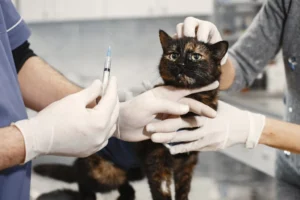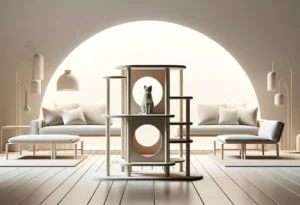Welcoming a new furry friend into your home means adapting your space to ensure it’s a safe haven for exploration and play. But let’s face it – your curious companion doesn’t always know what’s best for them. In the quest to keep your cat both happy and safe, your living room can suddenly seem like a jungle of potential hazards.
In this blog post, you’ll discover practical and easy-to-implement strategies to cat-proof your home effectively. We guarantee you’ll walk away with peace of mind, knowing you’ve created a feline-friendly environment where your cat can thrive.

Quick Takeaways:
- Replace toxic houseplants with cat-friendly alternatives like spider plants to mitigate risks of ingestion.
- Secure and conceal electrical cords with covers or cord clips to prevent chewing and potential electrocution.
- Ensure all medicines and chemicals are stored in child-proofed cabinets or lockable storage units to prevent accidental ingestion.
What Can You Do to Protect Your Cat from Harmful Plants?
As fur parents, we want to create a safe haven where our beloved furry friends can play, nap, and explore to their heart’s content. However, some common household plants can turn an adventure into a risky business. Cats are curious by nature and won’t hesitate to nibble on greenery that catches their eye, unaware of the dangerous consequences.
First off, it’s crucial to identify and remove toxic plants from your home. Common culprits include lilies, sago palm, and azaleas – beautiful but dangerous for our feline buddies. A thorough sweep through your house to spot and replace these with safe, cat-friendly plants can save you a trip to the vet. Spider plants, Boston ferns, and catnip are excellent choices that not only are safe for cats but also can enhance your indoor décor.
Sometimes, keeping certain plants may be unavoidable due to their sentimental value or as part of home aesthetics. In such cases, placing them out of paw’s reach—such as on high shelves or in hanging baskets—can keep your kitty safe from harm. One innovative tip most folks overlook is creating a “catio” area with safe plants for your cat to enjoy, keeping them away from the ones that could cause harm.
How to Secure Cords and Wires Away from Curious Paws?
Electrical cords and wires are like magnets for cats, who may view them as perfect toys for chewing and playing, oblivious to the electrocution risk and toxic substances they contain. To mitigate these dangers, securing cords and organizing them neatly is a must.
One way to hide cords is by using cord concealers or covers that blend with your walls or floors; they’re not only functional but can also compliment your home decor. Another savvy method involves using cord clips to attach wires to the back of desks and entertainment systems, keeping them out of sight and out of reach.
If you’re feeling a bit crafty, weaving cords through DIY fabric covers can add a splash of color to your room while protecting your cables and your cat. Moreover, for those areas where wires can’t be hidden or moved, consider using bitter-tasting sprays designed to deter pets from chewing.
What’s the Best Way to Store Chemicals and Medicines?
Cats possess an extraordinary ability to sneak into places they shouldn’t be, including where you store your medicines and household chemicals. This knack for exploration means it’s imperative to keep these substances tucked away securely.
Opt for cabinets with child-proof locks or invest in storage units that can be tightly sealed and locked. Always remember, the best spot is one your cat can’t reach, no matter how acrobatic they become. Additionally, never underestimate the cleverness of a determined cat; ensure all storage solutions are robust and consistently used.
An often overlooked yet critical tip is considering the storage of pet medications separately. While these might be safe when administered correctly, in the wrong paws, they can be just as dangerous. Opting for a dedicated storage box with a lock, within a locked cabinet, adds an extra layer of safety, ensuring your curious companion stays away from harm’s way.
Maintaining a cat-friendly home means staying vigilant and adapting your space to suit the needs and safety of your furry family member. By taking proactive steps towards identifying hazards and implementing creative solutions, you not only safeguard your pet but also foster a home environment where peace of mind and fun coexist harmoniously. Keep an eye out for more tips on creating a secure and enjoyable space for your feline friend in the following sections.
Can You Make Balconies and Windows Safe for Cats?
Absolutely, making your home’s windows and balconies safe for our feline friends is not just possible, it’s crucial for their well-being. The curiosity of a cat has no bounds; unfortunately, this can lead to dangerous situations when it comes to open windows and unprotected balconies. The last thing we want is for their adventurous spirit to place them in harm’s way.
Windows: The Gateway to Danger?
When it comes to windows, the danger comes from the possibility of falls or getting stuck in partially opened windows. To mitigate these risks, consider installing cat-proof window screens. Unlike standard screens, these are designed to withstand the clawing and pushing of your curious furball. It’s crucial to ensure that the screens are securely attached to the window frame to prevent any cat-astrophic escapes.
An alternative and a unique suggestion for those who love DIY projects is installing custom-made window ledges. Equip them with soft cushions and safety rails, turning a perilous window space into a safe spot for your cat to observe the world from the safety of your home.
Balconies: Elevated Risks
Balconies offer a different set of challenges, but they’re not insurmountable. The goal here is to create a secure outdoor space where your cat can enjoy fresh air without the risk of falling. A popular solution is to enclose your balcony with cat-safe netting or transparent cat-proof barriers. These solutions provide a clear view of the outside world while keeping your cat safely on the right side of the railing.
Don’t forget, though, balconies aren’t just about preventing falls. Ensure there are no toxic plants, and that all outdoor furniture is stable and cat-friendly. One innovative idea that’s often overlooked is setting up a “catio”—a patio for your cat. This can range from a simple window box extension to a fully equipped outdoor space on your balcony, complete with climbing posts and lounging areas.
How to Ensure Toys and Small Objects Aren’t Swallowed?
Cats have an innate need to chew and explore with their mouths, which can sometimes lead to the ingestion of objects that aren’t meant to be food. Choking hazards are a real concern for cat owners, especially when it comes to small toys and everyday household items.
Here are some key pointers to ensure that playtime is always safe:
-
Choose Appropriately Sized Toys : Opt for toys that are too large to be swallowed but still small enough for your cat to carry in their mouth. Avoid toys with small detachable parts that could become choking hazards.
-
Regular Inspections Are a Must : Make it a routine to check your cat’s toys for any signs of wear and tear. Damaged toys can break into smaller pieces and become dangerous. If a toy is starting to come apart, it’s time to replace it.
-
Be Mindful of Household Items : Cats are notorious for playing with things that aren’t actual toys. Ensure small, ingestible items like rubber bands, hair ties, and paper clips are kept out of reach. It’s remarkable how a seemingly harmless item can become a dangerous object in the paws of a curious cat.
-
Safe Materials : Ensure the toys you choose are made from safe, non-toxic materials. Unfortunately, not all pet toys are created equally. Doing a bit of research and reading product reviews can go a long way in making sure your furry friend’s toys are safe.
One piece of advice that’s often overlooked is creating a designated play area where you can control the environment. This area can be equipped with a variety of safe toys, scratching posts, and climbing structures that will not only keep your cat entertained but also away from potentially dangerous small objects. This doesn’t mean you can’t have interactive play sessions throughout your home, but it does provide a secure space where your cat can satisfy their need to explore and play safely.
Remember, cat-proofing your home is a continual process. As your cat grows and their behavior changes, you might need to update your strategies. By keeping these tips in mind, you’ll create a safer environment that allows your furry companion to explore and play to their heart’s content, without putting themselves at risk.
Alex, a passionate animal lover, has experience in training and understanding animal behavior. As a proud pet parent to two dogs and three cats, he founded AnimalReport.net to share insights from animal experts and expand his knowledge of the animal kingdom.









